When the hot summer arrives, air conditioning becomes indispensable to our daily lives in Japan. No matter how much I want to get by without it, the burning hot summer in Japan is unbearable. However, behind this convenience lurk problems we cannot ignore.
Staying in overly cooled indoor environments disrupts our body’s temperature regulation function, leading to fatigue, headaches, shoulder stiffness, and other discomforts. Moreover, using air conditioning daily increases electricity bills, placing a burden on household budgets.
Even more serious is the environmental impact. Air conditioners are among the highest electricity-consuming appliances in homes, and their massive power consumption directly contributes to increased carbon dioxide emissions. This represents a significant environmental issue closely linked to the progression of global warming.
Additionally, in the past, Freon gas that destroys the ozone layer was widely used as refrigerant in air conditioners. While current legal regulations prohibit its use in new units, older models may still contain it, requiring caution from an environmental protection standpoint.
Furthermore, the heat expelled by outdoor air conditioning units has been identified as one factor accelerating urban temperature rise phenomena, known as the heat island effect. There’s an ironic reality where our pursuit of coolness actually raises temperatures across entire cities.
Air Conditioning Use Increases Electricity Costs
When examining household power consumption during summer months in detail, it becomes clear how large a proportion air conditioning occupies.
Air conditioning accounts for an overwhelming 34.2% of household electricity consumption during summer, making it the largest power consumer among home appliances. This is because maintaining comfortable room temperatures requires continuous and substantial energy.
Air conditioner power consumption is greatly influenced by temperature settings. Just a 1°C (1.8°F) temperature adjustment can cause consumption variations of approximately 13% during cooling operation and 10% during heating operation.
The more extremely low (or high) you set the temperature, the greater the temperature difference with room temperature becomes, requiring more energy to bridge that gap. Therefore, maintaining appropriate temperature settings is key to efficient energy-saving operation.
Energy-Saving Basics You Can Start Today
“Continuous Operation vs. Frequent On/Off” – Which Saves More Energy?
You might wonder if it’s more energy-efficient to keep the air conditioning on all day or to turn it on and off frequently.
The answer to this question isn’t simple. In reality, the optimal operating method depends on the duration of absence. For short outings (approximately 30 minutes), continuous operation tends to consume less power, while for longer absences (over one hour), turning off the unit achieves greater energy savings.
This is due to air conditioner power consumption characteristics. Immediately after startup, maximum power is needed to lower room temperature to the set point, but once the target temperature is reached, operation switches to temperature maintenance mode, dramatically reducing power consumption. Turning off the unit during short absences means consuming large amounts of power again upon restart, making it counterproductive.
Set Temperature to Around 28°C (82°F)
Japan’s Ministry of the Environment recommends 28°C (82°F) as the optimal setting for summer air conditioning cooling operation. This temperature setting is a scientifically-based figure that balances comfort with energy efficiency.
While 28°C may initially feel warm, adequate comfort can be achieved through proper humidity management, airflow adjustment, and other techniques described below.
Regular Filter Cleaning
Air conditioner filter cleaning is extremely important for maintaining indoor air quality and minimizing power consumption.
Under normal usage conditions, monthly cleaning is recommended, but households with pets, dusty environments, or high-frequency air conditioner use may require more frequent maintenance every two weeks.
Clogged filters impede airflow, requiring more electricity to achieve the same cooling effect. Regular cleaning allows air conditioners to perform at maximum efficiency.
Blocking Sunlight
Sunshades like bamboo screens and curtains are excellent methods for effectively blocking direct sunlight and preventing rapid room temperature increases.
Installing them on windows exposed to strong afternoon western sun will provide particularly noticeable effects. Using these sunshades with air conditioning can shorten operating time and significantly contribute to reduced power consumption.
Boost Efficiency with Circulator Fans
Combining air conditioners with circulator fans is an excellent method that dramatically improves heating and cooling efficiency while reducing electricity costs.
Due to the physical property that cold air is heavy, cool air from air conditioners tends to accumulate near the floor. Circulating this cool air throughout the room with a circulator allows you to feel adequately cool while maintaining higher temperature settings.
For effective placement, utilize the natural characteristic of cool air flowing downward from air conditioners by positioning the circulator with its back to the air conditioner, blowing straight forward to lift floor-level cool air and achieve uniform cool air distribution throughout the room.
Comfortable Ideas Without Air Conditioning
Strategic Window Opening and Ventilation
Strategic window opening is effective for natural wind-based cooling. The most efficient method involves simultaneously opening two windows positioned diagonally across the room. This creates airflow pathways indoors, efficiently expelling trapped hot air outdoors.
On calm or windless days, placing fans or circulators near windows can artificially create airflow and enhance natural ventilation effects.
Cooling Products and Natural Material Bedding
To resolve nighttime sleeping discomfort, reusable ice pillows that can be frozen repeatedly and contact-cooling material bedding that provides instant cool sensations upon touch are highly effective.
Among natural materials, fibers like linen and cotton are excellent choices. These materials have high moisture absorption properties, quickly absorbing heat and moisture like sweat from the body and releasing it into the air.
Bamboo fiber bedding is also noteworthy. This natural fiber extracted from bamboo stems maintains natural antibacterial and deodorizing effects while demonstrating excellent functionality. Since bamboo grows extremely quickly and requires virtually no pesticides or chemical fertilizers during cultivation, it’s highly regarded as an environmentally-friendly sustainable material.
Night Ventilation Using Temperature Differences
The “night purge” nighttime ventilation method is an effective technique that naturally lowers room temperature by actively introducing outdoor air that’s cooler at night compared to daytime high temperatures.
Practicing this method can delay the next day’s air conditioning startup time or, in some cases, completely eliminate the need for daytime air conditioning use. Maximizing nighttime cool air utilization can potentially achieve significant power consumption reductions.
Conclusion
While there are various air conditioning energy-saving techniques, the most important aspect is practicing them within reasonable limits. Particularly for households with elderly members or small children, prioritize health above all else, using air conditioning appropriately to avoid compromising well-being.
Energy conservation efforts are meaningful actions that not only reduce household financial burdens but also contribute to global environmental protection. Start gradually with what you can manage, working toward a comfortable, environmentally-conscious summer lifestyle. Small accumulated efforts will eventually manifest as significant results.








